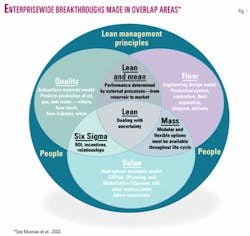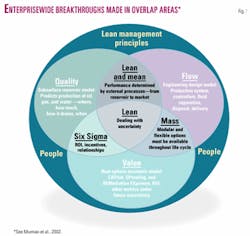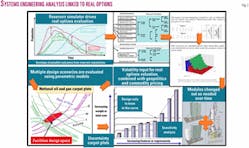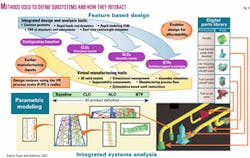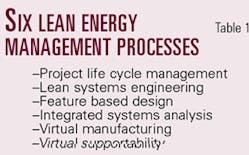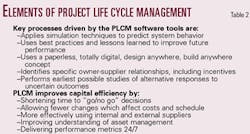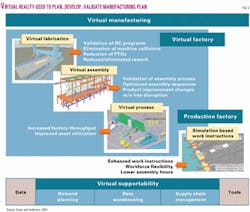LEAN ENERGY
MANAGEMENT—3
Ultradeepwater oil and gas exploration and development is a frontier much like landing on the moon was in the 1960s.
The offshore challenge is twofold: Deal with the risks and uncertainties of the technological frontier, while at the same time reducing the costs and cycle time required to exploit the resources by half or more. Only then can it become affordable in the first place.
Lean management processes and tools have created such fundamental improvements elsewhere, most notably in the aerospace and automotive industries. However, it has been well documented that the "behavior" of the entire system must fundamentally change in order to realize these lean improvements.
The core competencies of the owners are in subsurface reservoir uncertainty, not in design, procurement, fabrication, assembly, erection, and maintenance of the manufacturing "plants" that get the oil and gas to market. These skills reside with contractors that make up the engineering and construction (E&C) segment of the oil services industry.
Thus, all stakeholders must agree that such fundamental change is required. Once that behavioral barrier has been crossed, lean energy management (LEM) tools and processes must be imported and modified to deal with constantly changing reservoir uncertainty across the entire enterprise if we are to successfully execute a lean paradigm change for the ultradeepwater industry (Fig. 1).
Ultradeepwater status
The petroleum industry is highly technology dependent, especially in the upstream subsurface where imaging and resolution are key ingredients to the understanding of uncertainty that is the major risk to profitability.
Until the 1970s, research and development (R&D) budgets were comparable to those of other technology dependent manufacturers such as the aerospace and automotive industries. However, upstream research was focused on the physics of oil production and mechanisms for improved oil recovery, with little effort centered on better design and construction practices as has been the focal point of aerospace and automotive research for many years.
Aerospace R&D, for example, focuses on lean management process improvement, spending the equivalent of our geophysical research budgets on better design, construction, and maintenance processes and tools.
Beginning in the 1980s, the upstream R&D world turned grim. First signs of trouble were that overall revenues increased while research expenditures remained constant.
Then in the 1990s, research expenditures everywhere in the industry were downsized dramatically. Currently, upstream R&D is perhaps best described as both fragmented and highly focused on short-term, low-impact, applied research aimed at incremental technology improvements.
The offshore engineering & construction component of the industry has hardly invested in lean management process improvements at all, and consequently, the oil and gas industry lags the present state-of-the-art of other manufacturing industries substantially.
At the same time, the offshore industry desperately needs the cost and cycle-time improvements of lean management processes and tools so that the ultradeepwater can be economically developed. Capex costs are simply too high and cycle times too long by at least 50% to sustain development in such water depths. Incremental improvement won't help.
What major innovation efforts there are have centered on standardization, scaling up or down from previous designs, and customization where required. Risk assessment is focused on costs. Tasks are prioritized and critical paths identified, but stretch dates are allowed all too frequently, for too many assemblies, thus making delivery on time and on budget a very risky process.
First year operability hovers at 60%. Initial project approvals, in the first place, average a year or more just to get all the preproject issues with partners and contractors worked out so that agreement on a plan can proceed. It is common that up to 10% cost overruns do not have to go to management even for explanation, and as much as 15% cost overruns are routinely absorbed into the final project costs after the fact. In the deepwater, projects coming in under budget with early completion dates are unheard of.
Procurement is a particular problem. Procurement costs are only firmed up during the final details of the design phase, and there is consistently a 10-15% growth in component costs compared to project initiation allocations.
The deepwater industry is just now moving away from "get three bids and pick the cheapest" methodologies to establishing symbiotic, win/win business relationships with qualifying vendors–a hallmark of lean management.
It is not unusual for deepwater projects to involve 350,000 hr of cost-plus engineering time, but as often as not, uncertainty in the reservoir causes costly add-ons to what turn out to be inflexible designs. In sum, the ultradeepwater oil and gas industry is in great need of lean management innovation.
LEM tools and processes
Since 1998, we have conducted analyses of the possible impact of migration of lean tools and processes from aerospace into the ultradeepwater E&C industry (Fig. 2).
In particular, we have found that the deepwater industry is currently characterized by relatively low levels of information and knowledge sharing and collaboration among stakeholders in the three circles of Fig. 1, compared to that in lean industries.1
Other industries beyond aerospace and automotive, such as electronics, pharmaceuticals, and the military, have also overcome similar information "silos" by converting to a software-controlled lean management environment (first two parts of this series, OGJ, Mar. 17, 2003, p. 47, and May 19, 2003, p. 42).
These "far-field" industries have cut product development costs up to 25% per year.2 Exemplary in this regard is the "Toyota" manufacturing process of the 1980s, which converted the company from the maker of "junk cars" to the industry leader in sophisticated, cost effective engineering with the industry leading quality of its Lexus brand.
The aerospace industry quickly picked up these technologies and extended them. Perhaps the most famous implementation was the Boeing 777, known worldwide as the "paperless airplane." Boeing has designed and built four new airframe generations since the 777 airliner, and they cut costs and time-to-production half-again for each using lean management processes.3
Boeing has found that these cost and cycle-time savings can even be accomplished on one-of-a-kind production projects such as the X-32, X-45, and X-50 experimental air vehicles.
The lean processes and tools responsible for this improvement should be transferable to the energy industry because there are several key similarities between the aerospace and upstream energy industries.
Each has a multitude of contractors and suppliers located all across the globe. Both industries require close collaborative relationships between owners and contractors. They deal constantly with varying levels of digital sophistication amongst contractors and suppliers, who often use conflicting software applications for the same tasks. In addition, they both deal with complex security issues across their global enterprises.
Lean energy management is defined here as a methodology and tool set that seeks to integrate all design processes into one openly shared, 3D solid model (Fig. 2). LEM addresses planning, construction, installation, and maintenance, all together inside the same integrated systems model.
However, the uncertainties unique to ultradeepwater economic evaluation, appraisal, reservoir management, sea floor and subsurface facilities, fabrication, installation, well design, and drilling will have to be integrated into the LEM if we are to succeed in transferring lean efficiencies to the ultradeepwater E&C industry.
Such a paradigm shift to LEM should immediately affect positively on the cash flow and profitability of ultradeepwater developments. Lean management elsewhere has a large body of published documentation to prove that it has dramatically improved contractor partnerships, cut the cost of communicating design updates, added real time metrics of project progress, and cut the number of design modifications in half in the aerospace industry.4
The main objectives of LEM are to exploit the potential for significant improvements in cost and cycle time in the ultradeepwater by addressing the integration of design phases of large capex projects.
LEM tightly integrates:
- Lean tools for appraisal, planning, construction, operations, all the way to abandonment, with
- Lean processes in the organization for planning, scheduling, supervisory control, regulation, reservoir management, security, and environmental impact.
Included are major cost reductions and operability gains from enhanced project visibility and transparency, increased innovation, and the sharing of knowledge and understanding throughout the offshore enterprise. These gains come only because the vast majority of the people of the enterprise adopt lean management practices and break from the past to make it happen.
The implementation of LEM requires first and foremost, a better understanding of how lean processes and tools are able to perform more accurate design studies, account for uncertainty, and eliminate waste in the fabrication of offshore facilities.
Unique to the deepwater, there is a need to provide flexibility to system and subsystem designs through modularity. This need is in response to geological reservoir uncertainties which exist throughout all stages of all deepwater projects for both the surface and downhole. For example, we found that the "Lego block" modularity prevalent in the aerospace and auto industries has hardly penetrated the upstream energy industry to date.
The six major systems components of LEM are:
- Product life cycle management (Fig. 2), combined with
- A systems engineering approach (Fig. 3) to assist in the selection of the best concept to go to the select phase, which leads to
- Feature-based design (Fig. 4), which is then used for parametric modeling, morphing, and standardization driven by digital component libraries, that in turn facilitate
- An integrated analysis process (Fig. 4)
- Virtual manufacturing simulations (Fig. 5) that visualize the product environment, fabrication layout and generate electronic work-instructions, and finally
- Maintenance and supportability plans that are developed on the computer before any actual building begins.
LEM integration shortens the time and cost of E&C building by paradoxically maximizing the digital design time and preserving options, should later understanding of uncertainty yield a revised set of production parameters as the project matures. This dichotomy of shortening cycle time while providing more decision time is a hallmark of the Lean Management processes.5
The six LEM processes eliminate waste in the product development chain while assuring seamless information flow downward and amongst the owners and the myriad of contractors.
Integration of subsystems is required by the software tools. When one subcontractor changes a design specification, it propagates instantly to all other users of the LEM software system. Remote collaborations in 3D virtual reality are commonplace.
Earlier supplier involvement, reduced need for inspections, and many fewer parts, welds, and particularly rework orders, are the result. Cost and schedule controls are transparent and available for all to see.
We believe that a key to the success of LEM is the simulation of requirements and appraisal of needs using real options for quantifying cost versus added value of each decision along the critical path. Analyzing costs and defining the structures to be built, then planning the execution of the chosen design, testing operations and evaluating the options required by reservoir and market uncertainties–all are done on the computer before the first piece of steel is cut.
The reason for real options as a preferred choice over net present value in the LEM decisionmaking economic model is that real options require flexible manufacturing principles to be applied to the "factory." Real options are the modern way to quantitatively evaluate the costs and benefits of this flexibility.
Only if the system can be adequately simulated can we fully evaluate consequences before we take actions. Battlefield terms such as situational awareness, global visibility of assets and inventories, distribution and transportation options, and optimization of logistical supply chains then become relevant to the E&C industry.
Common actuators for LEM are single-source-of-product, standardization-across-platforms, parts-grouped-into-assembly KITS, and above all else, large-scale systems integration.
Resulting improvements are a digital library that allows attributes and geometries of all parts to be matched to create standard configurations and suppliers. Reduced design, tooling, and manufacturing instructions, increased procurement & manufacturing lot sizes, and efficiencies that minimize artificial shortages and surpluses in manufacturing and support follow (just-in-time).
Below, we examine the six processes of LEM more directly and discuss the tools and processes required to enact each in the ultradeepwater E&C industry.
Life cycle management
Project life cycle management (PLCM) seeks to link all data and processes across the appraise, select, define, execute and operate stages of ultradeepwater projects.
The result is faster, quicker, and better performance through enforced discipline, transparency and continuity of design and requirements over the full life cycle of each E&C project. PLCM consists of a set of tools that enforces this process rigor across the stakeholders all day, every day, throughout the project (Fig. 2).
For example, everything works off the same 3D solid model of the entire system being built. Automatic data updates assure linkages between analysis, simulations, and ultimate designs, shortening the definition and testing cycle.
"Smart software" flags interferences among bulkheads, electrical wiring, and piping. A digital parts library is integrated into the conceptual design process to limit the number of components and increase commonality among projects. Requirements and objectives are clearly recorded for all to see.
Risk management tools are used throughout to identify, assess, categorize, and strategize through a formalized risk mitigation process. An integrated planning process creates precedence diagrams for all subsystems and then computes a resource load schedule for critical paths. It tracks actions and provides daily progress metrics to all indicating actual costs and time versus plan for suppliers as well as owners.
Assembly is planned on the computer, and a 3D process map is created from start to finish of the project and signed-off by all before physical construction begins. Budgets are prepared from this bottom-up process map.
All this is done with commercial, off the shelf software (COTS) to assure availability throughout the chain of responsibility, including all subcontractors. Activity pert charts and electronic work instructions are then issued, and task load schedules are calculated so the project can be staffed. PLCM provides a single source for all procurements and bills-of-materiel.
Modularity is built into the PLCM system through software enforced distribution of the 3D solid model. Electronic schematics, 3D routing and installation layouts, subsystems analyses, and virtual prototyping are all shared with relevant suppliers by the software so that version mismatches, modifications that are incompatible with each other, and module conflicts are identified in the 3D solid model long before any construction occurs.
The virtual prototyping extends to fabrication so that modular change-out is built into the structures from day one. Reworking required from structural obstructions is eliminated. The assembly sequence itself, along with work instructions for the fabrication yard, are tested, optimized and distributed automatically.
Lean systems engineering
In aerospace, avionics engineers have used systems engineering to do their work, whereas vehicle and hardware engineers have designed components first and evaluated their performance later.
The latter methodology is closer to that used by deepwater E&C engineers. Lean management uses the systems engineering approach throughout the enterprise, a process that has proved far more efficient from both a cost-saving and time-saving standpoint.2
It requires that all significant owner and contractor requirements are thoroughly understood before a specific solution is developed to address these requirements. All disciplines (structural, manufacturing, quality, security, support, etc.) participate in the lean management systems engineering analysis.
Effects of modifications to one system can then be analyzed for adverse effects to other systems. In the early stages of the design process, this can be done manually because of the small sets of variables usually involved. However, as the design and analysis expands, COTS software tools are absolutely necessary.
Conflicting issues always emerge among fabrication, weight, cost, accessibility, maintenance, safety, and schedule. As these conflicts are resolved on the computer, the form, cost, and performance of the likely optimal system design slowly emerges.
Lean systems engineering data flow starts with the customer needs, objectives, and requirements described in terms of real options (Fig. 3). This leads to requirements analysis and carpet plots that evaluate the uncertainty window.
Functional requirements are reservoir capacity, oil, water, and gas processing streams, gas and liquid exports, disposal issues, and their possible variances. These then feed the design loop, where the actual concepts begin to take shape.
A baseline design is then traded against other possible concepts until a preferred concept emerges (wet vs. dry trees, FPSO vs. semisubmersible, for example). The design goes through a verification cycle to make sure initial requirements have all been addressed (lowest cost, minimal capex, a green solution, earliest oil, maximum recovery efficiency, etc).
Supplier conferences are then held to identify and evaluate alternative opportunities. Sensitivity analyses use parametric models that can be compared and changed as the design space changes.
Once all parts are parametrically described, then their operating characteristics and specifications are written in terms of equations that relate to all connecting parts that are interrelated. If a given part needs to be made larger, smaller, or relocated, its relationship to all connecting parts is calculated and propagated throughout the 3D solid model. The software automatically "morphs" the design of the whole system to the changes required by the new part, and sends it to all stakeholders.
The winning modular design may only satisfy 80% of the requirements at maximum production rates so that flow must be choked early-on, but long-term cost-effectiveness more than makes up for lost revenue later in the life cycle. This "knee in the curve" is the optimal design that trades-off costs and requirements as evaluated quantitatively by real options.
The preferred design then emerges first as a collection of alternatives that are sent along to the suppliers. After supplier feedback, a clearer definition of the ultimate design emerges.
A large scale, full system scenario is then simulated that evaluates the responsiveness of the design to variances caused by reservoir uncertainty, such as the possibility of producing much more gas that initially discovered, or more oil, or more water or any combinations thereof.
Other scenarios might be early water breakthrough, lower-than-expected or higher-than-expected well flow rates, poor sand control, or unpredicted injection efficiencies. Real options are used to identify and assess the relative value of design solutions to the uncertainties in the simulation.
The key is to design-in flexibility in both the surface and subsurface "factory floor" and to use real options in the decision procedure to enforce quantitative rigor. Gap analyses are conducted to further refine the concept and add lessons learned from the best practices database.
Operational, safety and environmental issues are then examined. Performance metrics are designed to monitor implementation. Metrics that track owner/contractor relationships and cross-organizational performance are particularly important to define, and efficiencies can then be proved. All this is done on the computer before any construction begins.
Feature-based analysis
The emergence of design conflicts leads to more and more in-depth computational analysis, or feature based design and integrated systems analysis.
These analyses focus in very specific areas, addressing unique issues that arise through simulations of variability. The critical conflicts usually cross disciplinary boundaries and involve three or more processes that in the "old way" would seldom have discussed alternatives with each other until after the need for painful reworking became obvious.
As the configuration matures, many of the most difficult issues re-appear. Electronic signoff then freezes features one after another until the "preferred design" emerges.
A configuration baseline emerges in the feature based design process (Fig. 4), whereby conceptual assembly layouts and "build to" packages are designed using the digital parts library. These, in turn, automatically define supportability requirements.
Integrated systems analysis is then used to test functional capabilities of the new assemblies, their ties to central control panels, and multiple subsystem integration capabilities. Functional electrical schematics and logic diagrams are then automatically generated for each subsystem.
For example, a "smart router" is used to determine best path layouts for the electrical wiring and high-pressure piping. Additions to the 3D solid model are created using most-direct-route manufacturing rules.
Electronic schematics are created quickly and linked directly to the 3D solid model. Fluid and electrical systems analyses are then performed to verify functionality and safety. A virtual prototype of the facility emerges, ready for the manufacturing simulation.
Virtual manufacturing and supportability
Virtual manufacturing tools then simulate the "factory floor" or fabrication yard to layout the most efficient construction sequence for the project (Fig. 5).
It strips away the engineering equations and presents the 3D construction sequence with an electronic, view-from-any-angle, fly-through capability networked to all team members, including contractors at remote sites. Comments and corrections are solicited from all before any building is begun. Electronic work orders and 3D schematics are then generated and construction starts.
Virtual supportability takes the 3D solid model and adds operational and maintenance instructions. It incorporates simulations of complicated maintenance tasks, including placing human sized repair crews and ROVs into a virtual reality environment to make sure tolerances will allow maintenance access. Virtual support begins operator training in operational and maintenance tasks even as the facilities are being constructed.
The supply chain is laid out along with procurement sequences. Historical requirements, forecasts, and consolidation of demand (turn rates) are used to determine appropriate sourcing and just-in-time delivery schedules.
Cost-cycle time gains
How can the ultradeepwater industry effectively evaluate the risks associated with conversion to LEM processes and tools?
Until the offshore E&C industry has a substantial track record of LEM improvement, cost and cycle time impact can be estimated by considering the following steps applied to all the process subsystems:
- Use previous project experience of your personnel to describe the as is state of project subsystem tasks.
- Define savings based on other lean industry performances at similar subsystem tasks.
- Add uncertainty factors for industry differences (may initially be as high as 50%, but will drop over time.
- Add in worst case delays and confusion from first-time use of LEM tools and processes.
Contrast the economic value of these risks against estimates from your own personnel of the positive value of:
- Reduced instruction ambiguity.
- Faster reviews of options.
- Earlier scheduling decisions.
- Better supplier and fabricator collaboration.
- Improved visibility of the total project.
- Improved change-order management.
- Reduced site queries.
- Better health, safety, and environmental impact assessments.
- Improved interfaces between contractors for hookup and commissioning.
- Supply chain improvement.
Summary
The major difference between LEM and what the offshore E&C industry uses today is that the tools and processes for each task are not currently integrated to implement a systemwide, 3D solid model.
In today's xml and web-services world of COTS software, tools can be integrated to produce the required seamless digital environment. The value of that transformation should become evident as the checklist described above is worked through.
The costs of designing, building, fabricating, installing, and operating for 20 years or more the ultradeepwater "plants" that produce the hard-to-get gas and oil reserves of the world's ultradeepwater basins must be cut substantially (in half) if we as an industry are to benefit from the harvesting of these supplies–a truly grand challenge (see also the first two parts of this series).
Even then, the cycle time required to bring new ultradeepwater discoveries to market must be cut in half to make development cost-effective. Not only new offshore hardware, but more importantly, lean software and process re-engineering are required.
Once installed, the LEM system must then be kept open to best-in-breed improvement solutions. Most importantly, people must re-invent their workplaces. All stakeholders must work together before the required cost and cycle time savings from lean energy management can make the ultradeepwater a return-on-investment worth pursuing.
References
- Esser, W., and Anderson, R., "The Advanced Digital Enterprise in the Ultra-Deepwater Development," Offshore, October 2000.
- Anderson, R., and Esser, W., "Energy Company as Advanced Digital Enterprise," American Oil & Gas Reporter, 2001.
- Esser, W., and Anderson, R., "Visualization of the Advanced Digital Enterprise," Offshore Technology Conference, May 2001.
- See website (http://lean.mit.edu).
- Murman, E., et al., "Lean Enterprise Value," Palgrave Press, 2003.
Bibliography
- Anderson, R., "Oil Production in the 21st Century," Sci. Am., Vol. 278, 1998, pp. 86-91.
- Anderson, R., Boulanger, A., Longbottom, J., and Oligney, R., "Lean Energy Management—1: Required for Economic Ultradeepwater Development," OGJ, Mar. 17, 2003, p. 47.
- Anderson, R., and Boulanger, A., "Lean Energy Management—2: Designing Uncertainty into the Enterprise," OGJ, May 19, 2003, p. 42.
- Walker, D., "Ultradeepwater Technologies," SPE Distinguished Lecture, 2003.
- Womack, J., and Jones, D., "Lean Thinking," Simon & Schuster, 1996.
